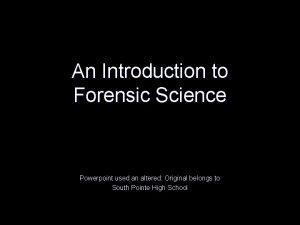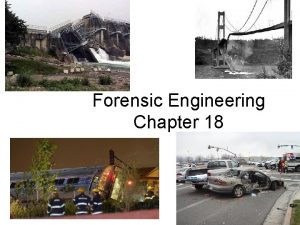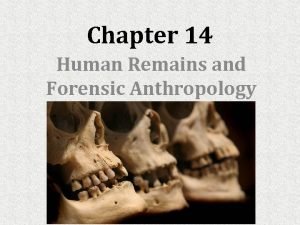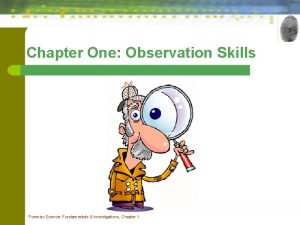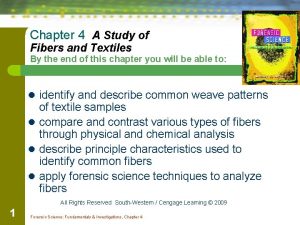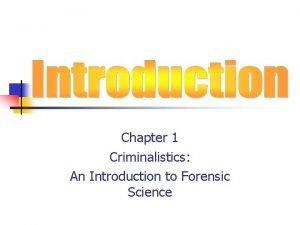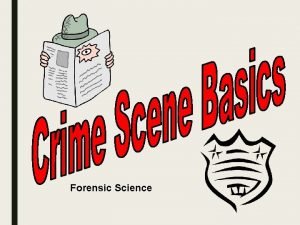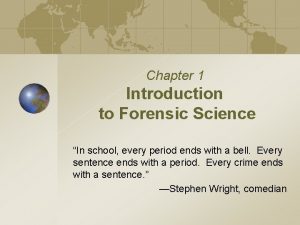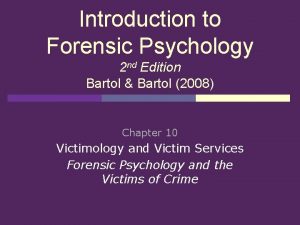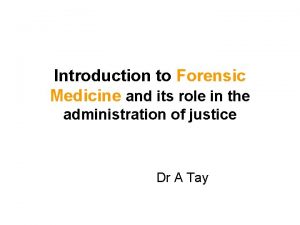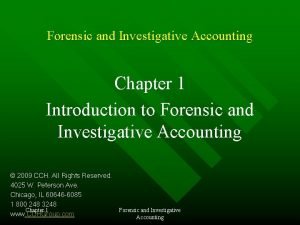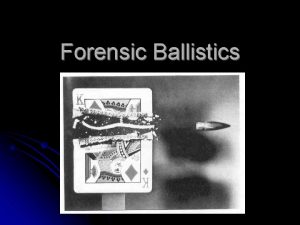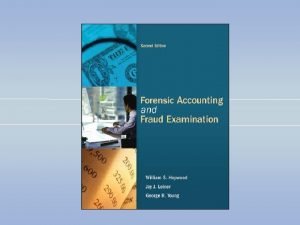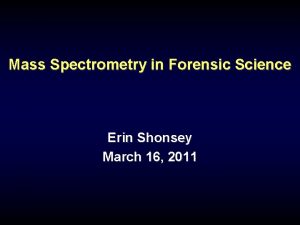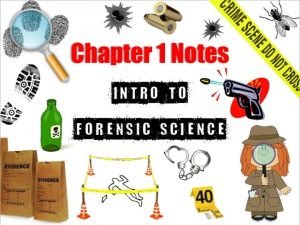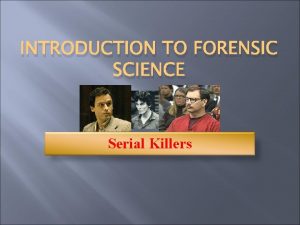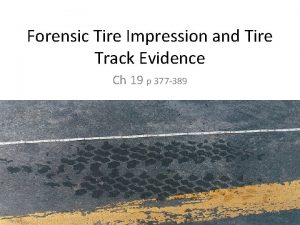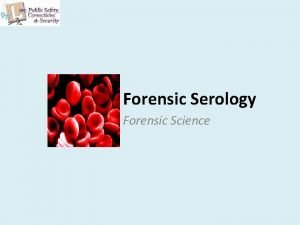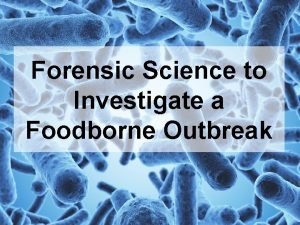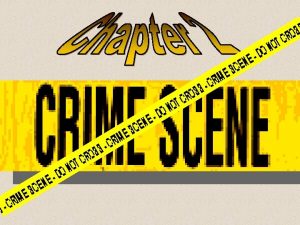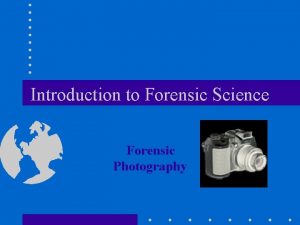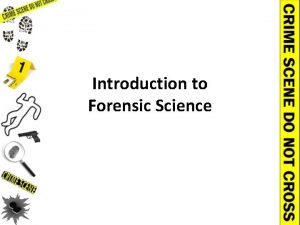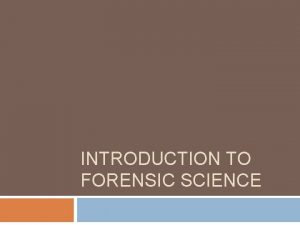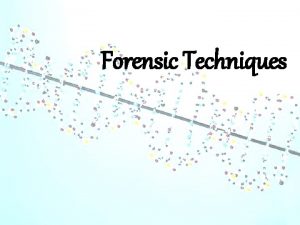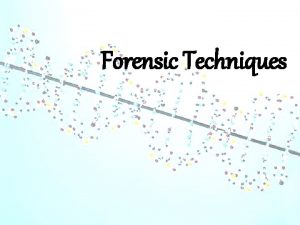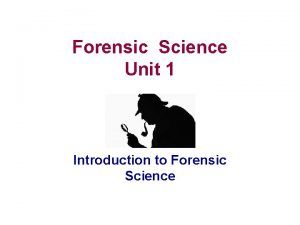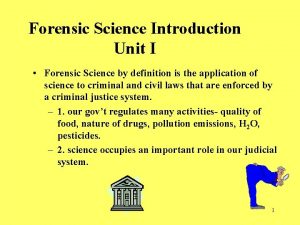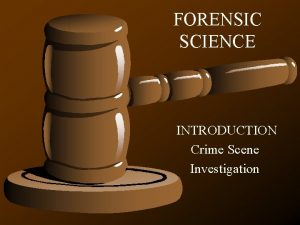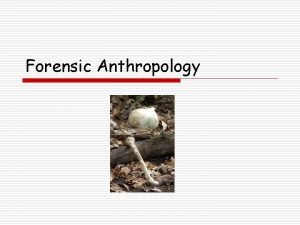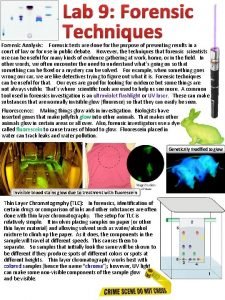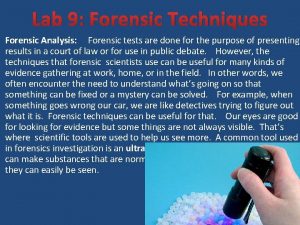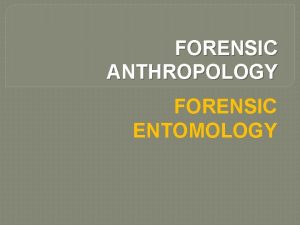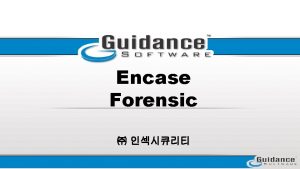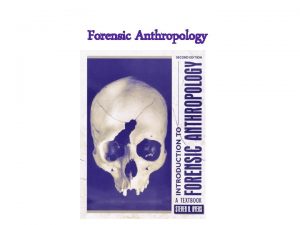Introduction to Forensic Science Chapter 1 Forensic Science
































- Slides: 32

Introduction to Forensic Science Chapter 1

Forensic Science • It is the study and application of science to matters of law (criminal and civil) • Includes the business of providing timely, accurate, and thorough information to all levels of decision makers in our criminal justice system • Also called criminalistics

Criminalists vs Criminologists • A criminalist examines physical evidence for legal purposes • Criminologists study the crime scene for motive, traits, and behavior as to help interpret the evidence – They learn to think like criminals

Forensic Scientists • Applies the principles and techniques of the physical and natural sciences to the analysis of the many types of evidence that may be recovered during a criminal investigation • May also provide expert court testimony – Known as an expert witness • Individual whom the court determines possesses knowledge relevant to the trial

Developments in Forensic Science • 700 s AD- Chinese used fingerprints to establish identity of documents and clay sculptures • ~1000 - Roman courts determined that bloody palm prints were used to frame a man in his brother’s murder • 1149 - King Richard of England introduced the idea of the coroner to investigate questionable death • 1200 s- A murder in China is solved when flies were attracted to invisible blood residue on a sword of a man in the community • 1598 - Fidelus was first to practice forensic medicine in Italy

Developments in Forensic Science • 1670 - Anton van Leeuwenhoek constructed the first high powered microscope • 1776 - Paul Revere identified the body of General Joseph Warren based on the false teeth he had made for him • 1784 - John Toms convicted of murder on basis of torn edge of wad of paper in pistol matching a piece of paper in his pocket • 1859 - Gustav Kirchoff and Robert Bunsen developed the science of spectroscopy • 1864 - Crime scene photography developed

Developments in Forensic Science • 1879 - Alphonse Bertillion developed a system to identify people using particular body measurements • 1896 - Edward Henry developed the first classification system for fingerprint identification • 1900 - Karl Landsteiner identified human blood groups • 1904 - Edmond Locard formulated his famous principle, “Every contact leaves a trace” • 1922 - Francis Aston developed the mass spectrometer

Developments in Forensic Science • 1959 - James Watson and Francis Crick discover the DNA double helix • 1977 - AFIS developed by FBI, fully automated in 1996 • 1984 - Jeffrey’s developed and used the first DNA tests to be applied to a criminal case

People of Historical Significance • Mathieu Orfila- father of forensic toxicology • Alphonse Bertillion- devised first scientific system of personal identification • Francis Galton- conducted first definitive study of fingerprints and their classification • Leone Lattes- developed a procedure to determine blood type from dried bloodstains • Calvin Goddard- used a comparison microscope to determine if a particular gun fired a bullet

People of Historical Significance • Albert Osborn- developed the fundamental principles of document examination • Walter Mc. Crone- utilized microscopy to examine evidence • Hans Gross- wrote treatise on criminal investigation • Edmond Locard- considered the father of criminalistics; responsible for Locard’s exchange principle – States that when a criminal comes in contact with an object or a person, a cross transfer of evidence occurs

The Crime Lab • Characterized by rapid growth due to – Supreme Court decisions in the 1960 s placing greater emphasis on scientifically evaluated evidence – Accelerated drug abuse – Initiation of DNA profiling • 350 public crime labs exist at federal, state, county, and municipal levels

The Crime Lab • History – First established in 1910 by Locard – First police crime lab established in 1923 in Los Angeles, CA – Scientific Crime Detection Lab established in 1929 – First FBI crime lab opened in 1932

Crime Lab Services • 5 exist – Physical science – Biology – Firearms – Document – Photographic

Physical Science Unit • Incorporates the principles of chemistry, physics, and geology to identify and compare physical evidence

Biology Unit • Applies the knowledge of biological sciences in order to investigate blood samples, body fluids, hair, and fiber samples

Firearms Unit • Investigates discharged bullets, cartridge cases, shotgun shells, and ammunition

Document Unit • Provides the skills needed for handwriting analysis and other questioned document issues

Photographic Unit • Applies specialized photographic techniques for recording and examining physical evidence

Other Crime Lab Services • Toxicology Unit- examines body fluids and organs for the presence of drugs and poisons • Latent Fingerprint Unit- processes and examines evidence for latent fingerprints • Polygraph Unit- conducts polygraph or lie detector tests • Voiceprint Analysis Unit- attempts to tie a recorded voice to a particular suspect • Evidence Collection Unit- dispatches specially trained personnel to the crime scene to collect and preserve physical evidence

Other Forensic Science Services • Forensic Pathology- concentrate closely on the understanding of types and causation of injuries and causes of sudden and unnatural death – Deals with the different stages of death


Special Forensic Science Services • After a human body expires there are several stages of death. – Rigor mortis results in the shortening of muscle tissue and the stiffening of body parts in the position at death (occurs within the first 24 hours and disappears within 36 hours). – Livor mortis results in the settling of blood in areas of the body closest to the ground (begins immediately on death and continues up to 12 hours). – Algor mortis results in the loss of heat by a body (a general rule, beginning about an hour after death, the body loses heat by 1 to 1 -1/2 degrees Fahrenheit per hour until the body reaches the environmental temperature).

Other Forensic Science Services • Forensic Anthropology-concentrates on the identification of deceased individuals whose remains are decomposed, burned, mutilated or otherwise unrecognizable • Forensic Entomology- is the study of insects and their relation to a criminal investigation, commonly used to establish the time of death • Forensic Psychiatry- work with courts in evaluating an individual's competency to stand trial, defenses based on mental diseases or defects (e. g. , the "insanity" defense), and sentencing recommendations

Other Forensic Science Services • Forensic Odontology- evaluates teeth to determine the identification of the deceased • Forensic Engineering- investigation of materials, products, structures or components that fail or do not operate/function as intended, causing personal injury for example • Cybertechnology- involves the examination of digital evidence

Skills of a Forensic Scientist • A forensic scientist must be skilled in applying the principles and techniques of the physical and natural sciences to the analysis of the many types of evidence that may be recovered during a criminal investigation. • A forensic scientist may also provide expert court testimony. • An expert witness is an individual whom the court determines possesses knowledge relevant to the trial that is not expected of the average person.

Skills of a Forensic Scientist • The expert witness is called on to evaluate evidence based on specialized training and experience that the court lacks the expertise to do. • The expert will then express an opinion as to the significance of the findings. • Forensic scientists also participate in training law enforcement personnel in the proper recognition, collection, and preservation of physical evidence.

The Frye Standard • The Frye v. United States decision set guidelines for determining the admissibility of scientific evidence into the courtroom. • To meet the Frye standard, the evidence in question must be “generally accepted” by the scientific community.

Frye Not Absolute • However, in the 1993 case of Daubert v. Merrell Dow Pharmaceutical, Inc. , the U. S. Supreme Court asserted that the Frye standard is not an absolute prerequisite to the admissibility of scientific evidence. • Trial judges were said to be ultimately responsible as “gatekeepers” for the admissibility and validity of scientific evidence presented in their courts, as well as all expert testimony.

The Daubert Criteria • In Daubert, the Supreme Court offered some guidelines as to how a judge can gauge scientific evidence: 1) Whether the scientific technique or theory can be (and has been) tested. 2) Whether the technique or theory has been subject to peer review and publication. 3) The technique’s potential rate of error.

The Daubert Criteria 4) Existence and maintenance of standards controlling the technique’s operation. 5) Whether the scientific theory or method has attracted widespread acceptance within a relevant scientific community.

Major Crime Labs • FBI- Federal Bureau of Investigations • DEA- Drug Enforcement Agency • ATF- Bureau of Alcohol, Tobacco, Firearms, and Explosives • US Postal Service • US Fish and Wildlife Service

The Crime Scene Team • A group of professional investigators, each trained in a variety of special disciplines • Team members include – – – First police officer on the scene Medics (if necessary) Investigator(s) Medical examiner Photographer and/or Field Evidence Technician Lab Experts
 Forensic science chapter 1
Forensic science chapter 1 Branches of forensic science ppt
Branches of forensic science ppt Unit 1 introduction to forensic science
Unit 1 introduction to forensic science Forensic science an introduction
Forensic science an introduction Forensic pathologist vs forensic anthropologist
Forensic pathologist vs forensic anthropologist Forensic psychiatry vs forensic psychology
Forensic psychiatry vs forensic psychology Forensic science chapter 18 review answers
Forensic science chapter 18 review answers What is nibis
What is nibis Chapter 14 forensic anthropology
Chapter 14 forensic anthropology Forensic observation
Forensic observation Forensic science fundamentals and investigations chapter 6
Forensic science fundamentals and investigations chapter 6 Forensic science chapter 4 fibers and textiles
Forensic science chapter 4 fibers and textiles Hans gross forensic science
Hans gross forensic science Forensic science vocabulary
Forensic science vocabulary Forensic science chapter 1
Forensic science chapter 1 K5 think central
K5 think central My favourite subject science
My favourite subject science Introduction to forensic psychology bartol pdf
Introduction to forensic psychology bartol pdf Introduction to forensic medicine
Introduction to forensic medicine Introduction to forensic accounting
Introduction to forensic accounting What is balistics
What is balistics Introduction to forensic accounting
Introduction to forensic accounting Hegar's sign in pregnancy
Hegar's sign in pregnancy Hair forensic analysis
Hair forensic analysis Mass spectrometry in forensic science
Mass spectrometry in forensic science Who established the first workable crime laboratory
Who established the first workable crime laboratory Different types of serial killers
Different types of serial killers Leone lattes contribution to forensic science
Leone lattes contribution to forensic science Tire track evidence
Tire track evidence Cins ve tür arasındaki farkı örneklerle açıklayınız
Cins ve tür arasındaki farkı örneklerle açıklayınız Forensic science foodborne outbreak investigation answers
Forensic science foodborne outbreak investigation answers Definition of forensic science
Definition of forensic science Forensic science begins at the crime scene.
Forensic science begins at the crime scene.

